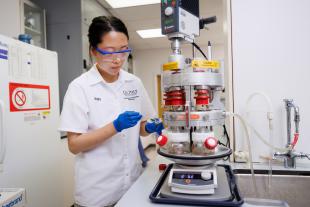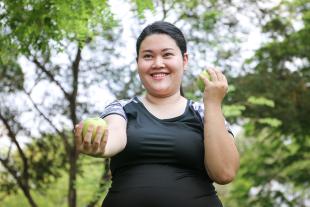Faculty, Staff Leverage $32 Million in Research Grants in 2016-17
Holders of two patents also honored, along with two faculty members who secured a combined $30 million in external funding over their careers at the university
Cal Poly honored university researchers who spent more than $32 million in research funding; obtained 310 new grants valued at nearly $22 million; and secured two patents in the 2016-17 fiscal year.
The patented inventions include an improved statistical method for more accurate assessment of recycled plastic content for manufacturing as well as a specialized filter designed to work with a portable water-treatment bag.
“I am very excited about all the work we are doing and our investment in undergraduate- and master’s-level research,” said Provost Kathleen Enz Finken. “I’m proud of the innovative and creative contributions we are making to industry, in the social sciences, and the arts and humanities.
“I know we have a great future in this as we continue to build our capacity across all areas.”
Chris Kitts, the university’s interim dean of research, said research grants offer Learn by Doing opportunities for Cal Poly students.
“Research brings new ideas, opportunities and avenues of exploration and practice to Cal Poly,” Kitts said at a recent reception for the campus research community. “One way we track our success as a research university is by dollar awards. Together, we spent about $32 million on research across the six colleges. That is encouraging.”
Public and private grants result in tuition, fees and scholarships for students, he added. Moreover, the awards also purchase lab equipment across the university, support the wages of Cal Poly Corp. employees, and employ hundreds of student-researchers each year.
Two faculty members who secured a combined $30 million in grant funding over their Cal Poly careers were honored:
Stuart Styles, director of the university’s Irrigation Training and Research Center, was saluted for more than $25 million in total funding. The IRTC was established in 1989 as a center of excellence, building on a history of Cal Poly’s contributions to the irrigation industry. More than half of its work (65 percent) is through direct technical assistance, and the remainder is split between applied government- and industry-funded research (20 percent) and training opportunities (15 percent).
- David Marshall, who heads the aerospace engineering department in the College of Engineering, was honored for securing more than $5 million in grants, which funded research on the AMELIA, the Advanced Model for Extreme Lift and Improved Aeroacoustics, a 100-passenger, next-generation airliner. The fuel-efficient aircraft, quieter than existing craft, is designed with short take-off and landing capabilities to make it practical for regional airports.
- Four university centers that each received more than $1 million in grants and those who manage them were singled out: Styles and Charles Burt of the IRTC; John Keller and Chance Hoellwarth of the Center for Excellence in Science and Mathematics Education (CESaME); Sam Blakeslee of the Institute for Advanced Technology and Public Policy (IATPP); and Suzanne Phelan of the Center for Solutions Through Research in Diet and Exercise (STRIDE).
Patent holders from the 2016-17 academic year were also praised:
— Keith Vorst of the Orfalea College of Business, patent issued May 2, 2017, for “Systems and Methods for Determining Recycled Thermoplastic Content.” This is a follow-up to a related patent that was issued in 2011, said Jim Dunning, director of Economic Development and Technology Transfer. “It’s the technology to verify the percent of recycled plastic content in thermoplastics,” he said. “If you buy a bottle of water that says 50 percent recycled plastic content, this method can verify that it is 50 percent.”
— Trygve Lundquist of the College of Engineering, patent issued Aug. 22, 2017, for “Field Water Purification System Filter,” which is part of a family of patents for a portable personal water-treatment system that is being manufactured and marketed by a former student, Dunning said.
Two project leaders were honored for hiring graduate and undergraduate student assistants.
The IATPP’s Blakeslee spent more than $200,000 on undergraduate student wages for “Digital Democracy,” an online platform with a searchable database of state legislative committee hearings. And Christopher “Chip” Appel was singled out for the $27,000 spent on graduate student support for his “Forest Resilience in the Sierra” project in the College of Agriculture, Food and Environmental Sciences’ natural resource management and environmental sciences department.
Kitts also recognized individuals with the highest grant funding totals in their colleges:
— College of Agriculture, Food and Environmental Sciences: Stuart Styles, bioresource and agricultural engineering.
— College of Architecture and Environmental Design, Michael Boswell, city and regional planning, a grant initiated by the late W. David Conn, a professor emeritus of city and regional planning who died March 8, 2017.
— College of Engineering, Jim Hanson, civil and environmental engineering department.
— College of Liberal Arts, Patrick Lin, philosophy department.
— College of Science and Mathematics, Suzanne Phelan, kinesiology department.
— Orfalea College of Business: Tod Nelson, the Center for Innovation and Entrepreneurship.
And new this year, the Office of Research and Economic Development’s Grants Development (GDO) and Sponsored Programs offices (SPO), staffers who work directly overseeing and administering the grants, presented recognition awards:
— Best Partner Principle Investigators (PI): Greg Schwartz of the bioresource and agricultural engineering department (SPO), and Jennifer Klay of the physics department (GDO);
— Most Impactful Projects: Stephen Klisch of the mechanical engineering department for “Joint Loads and Cartilage Stress in Intact Joints of Military Transtibial Amputees: Enhancing Quality of Life” (SPO); and Elisabeth Sperow of the accounting department for the “Low Income Taxpayer Clinic” (GDO);
— Most Interesting Project: Nathaniel Martinez of the biological sciences department, for “Miniaturized Paper as a Low-Cost, Patternable, Shapable and Degradable Scaffold for Cell Culture and Tissue Engineering,” was the unanimous choice of both offices. This new material will include the development of tissue-engineered blood vessels, which could have important implications for future medically relevant applications.




